A High-Precision Positioning Method for Autonomous Underwater Vehicles with Communication Delays
Abstract
:1. Introduction
- To enhance the accuracy of AUV positioning, this work introduces the issue of communication delays during underwater positioning and analyzes its impact on EKF nonlinear filtering.
- To address the localization error induced by communication delay, we propose a localization compensation algorithm. This algorithm compensates for the localization information by reconstructing the measured data, resulting in a more accurate position.
- To optimize the reconstructed measurement information, we propose a Doppler-corrected angle method. This approach corrects the heading angle of AUV motion using Doppler measurement information, effectively mitigating the issue of cumulative angular errors in the reconstructed measurement information.
- The efficacy of the proposed metrology update algorithm, incorporating Doppler correction, is validated through simulation experiments. In contrast to traditional algorithms, the proposed algorithm proficiently mitigates the issue of cumulative errors in angle measurements, thereby elevating the precision of localization.
2. Underwater Positioning Methods
2.1. Positioning Model without Latency
2.2. Extended Kalman Filter Estimation
3. Communication Delay Compensation Algorithm
3.1. Compensation Algorithm Based on Measurement Update
3.2. Doppler Correction
3.2.1. Usability Analysis
3.2.2. Analysis of the Doppler Correction Algorithm
| Algorithm 1 Position estimation based on Doppler-corrected angles |
|
4. Simulation
5. Conclusions
Author Contributions
Funding
Data Availability Statement
Conflicts of Interest
References
- Paull, L.; Saeedi, S.; Seto, M.; Li, H. AUV navigation and localization: A review. IEEE J. Ocean. Eng. 2013, 39, 131–149. [Google Scholar] [CrossRef]
- Wakita, N.; Hirokawa, K.; Ichikawa, T.; Yamauchi, Y. Development of autonomous underwater vehicle (AUV) for exploring deep sea marine mineral resources. Mitsubishi Heavy Ind. Tech. Rev. 2010, 47, 73–80. [Google Scholar]
- Wang, Y.; Gu, D.; Ma, X.; Wang, J.; Wang, H. Robust Real-Time AUV Self-Localization Based on Stereo Vision-Inertia. IEEE Trans. Veh. Technol. 2023, 72, 7160–7170. [Google Scholar] [CrossRef]
- Guo, J.; Li, D.; He, B. Intelligent collaborative navigation and control for AUV tracking. IEEE Trans. Ind. Inform. 2020, 17, 1732–1741. [Google Scholar] [CrossRef]
- Kepper, J.H.; Claus, B.C.; Kinsey, J.C. A navigation solution using a MEMS IMU, model-based dead-reckoning, and one-way-travel-time acoustic range measurements for autonomous underwater vehicles. IEEE J. Ocean. Eng. 2018, 44, 664–682. [Google Scholar] [CrossRef]
- Stojanovic, M. Recent advances in high-speed underwater acoustic communications. IEEE J. Ocean. Eng. 1996, 21, 125–136. [Google Scholar] [CrossRef]
- Chitre, M.; Shahabudeen, S.; Stojanovic, M. Underwater acoustic communications and networking: Recent advances and future challenges. Mar. Technol. Soc. J. 2008, 42, 103–116. [Google Scholar] [CrossRef]
- Yang, G.; Dai, L.; Wei, Z. Challenges, threats, security issues and new trends of underwater wireless sensor networks. Sensors 2018, 18, 3907. [Google Scholar] [CrossRef]
- Caiti, A.; Crisostomi, E.; Munafò, A. Physical characterization of acoustic communication channel properties in underwater mobile sensor networks. In Proceedings of the Sensor Systems and Software: First International ICST Conference, S-CUBE 2009, Pisa, Italy, 7–9 September 2009; Revised Selected Papers 1. Springer: Berlin, Germany, 2010; pp. 111–126. [Google Scholar]
- Li, L.; Li, Y.; Zhang, Y.; Xu, G.; Zeng, J.; Feng, X. Formation Control of Multiple Autonomous Underwater Vehicles under Communication Delay, Packet Discreteness and Dropout. J. Mar. Sci. Eng. 2022, 10, 920. [Google Scholar] [CrossRef]
- Zhou, L.; Wang, M.; Zhang, X.; Qin, P.; He, B. Adaptive SLAM Methodology Based on Simulated Annealing Particle Swarm Optimization for AUV Navigation. Electronics 2023, 12, 2372. [Google Scholar] [CrossRef]
- Qu, J.; Sun, G.; Zhang, J.; Li, X.; Mao, Y.; Wang, J. Optimality analysis for formation of Multi-AUV cooperative positioning based on genetic algorithm. In Proceedings of the 2021 IEEE International Conference on Real-time Computing and Robotics (RCAR), Xining, China, 15–19 July 2021; pp. 578–583. [Google Scholar]
- Ling, H.; Zhu, T.; He, W.; Zhang, Z.; Luo, H. Cooperative search method for multiple AUVs based on target clustering and path optimization. Nat. Comput. 2021, 20, 3–10. [Google Scholar] [CrossRef]
- Lu, J.; Chen, X.; Luo, M.; Zhou, Y. Cooperative localization for multiple AUVs based on the rough estimation of the measurements. Appl. Soft Comput. 2020, 91, 106197. [Google Scholar] [CrossRef]
- Chang, L.; Qin, F.; Xu, J. Strapdown inertial navigation system initial alignment based on group of double direct spatial isometries. IEEE Sens. J. 2021, 22, 803–818. [Google Scholar] [CrossRef]
- Ji, D.X.; Fang, W.W.; Zhu, H.; Li, S.; Tang, Y.G.; Tian, Y.; Yao, Q. Active Localization of Autonomous Underwater Vehicle Using Noisy Relative Measurement. Acta Electonica Sin. 2021, 49, 1249. [Google Scholar]
- Stutters, L.; Liu, H.; Tiltman, C.; Brown, D.J. Navigation Technologies for Autonomous Underwater Vehicles. IEEE Trans. Syst. Man Cybern. Part C Appl. Rev. 2008, 38, 581–589. [Google Scholar] [CrossRef]
- Miller, P.A.; Farrell, J.A.; Zhao, Y.; Djapic, V. Autonomous Underwater Vehicle Navigation. IEEE J. Ocean. Eng. 2010, 35, 663–678. [Google Scholar] [CrossRef]
- Du, C.; Li, F.; Shi, Y.; Yang, C.; Gui, W. Integral Event-Triggered Attack-Resilient Control of Aircraft-on-Ground Synergistic Turning System With Uncertain Tire Cornering Stiffness. IEEE/CAA J. Autom. Sin. 2023, 10, 1276–1287. [Google Scholar] [CrossRef]
- Du, C.; Shi, Y.; Li, F.; Yang, C.; Gui, W. An Improved Co-Design Method of Dynamical Controller and Asynchronous Integral-Type Event-Triggered Mechanisms. IEEE Trans. Syst. Man, Cybern. Syst. 2023, 53, 2500–2509. [Google Scholar] [CrossRef]
- Ji, D.; Deng, Z.; Li, S.; Ma, D.; Wang, T.; Song, W.; Zhu, S.; Wang, Z.; Pan, H.; Sharma, S.; et al. A Novel Case of Practical Exponential Observer Using Extended Kalman Filter. IEEE Access 2018, 6, 58004–58011. [Google Scholar] [CrossRef]
- Hargrave, P. A tutorial introduction to Kalman Filtering. In Proceedings of the IEE Colloquium on Kalman Filters: Introduction, Applications and Future Developments, IET, London, UK, 21–21 February 1989; p. 1. [Google Scholar]
- Xia, X.; Hashemi, E.; Xiong, L.; Khajepour, A. Autonomous vehicle kinematics and dynamics synthesis for sideslip angle estimation based on consensus Kalman Filter. IEEE Trans. Control. Syst. Technol. 2022, 31, 179–192. [Google Scholar] [CrossRef]
- Xiong, L.; Xia, X.; Lu, Y.; Liu, W.; Gao, L.; Song, S.; Yu, Z. IMU-based automated vehicle body sideslip angle and attitude estimation aided by GNSS using parallel adaptive Kalman Filters. IEEE Trans. Veh. Technol. 2020, 69, 10668–10680. [Google Scholar] [CrossRef]
- Liu, W.; Xia, X.; Xiong, L.; Lu, Y.; Gao, L.; Yu, Z. Automated vehicle sideslip angle estimation considering signal measurement characteristic. IEEE Sens. J. 2021, 21, 21675–21687. [Google Scholar] [CrossRef]
- Xia, X.; Xiong, L.; Huang, Y.; Lu, Y.; Gao, L.; Xu, N.; Yu, Z. Estimation on IMU yaw misalignment by fusing information of automotive onboard sensors. Mech. Syst. Signal Process. 2022, 162, 107993. [Google Scholar] [CrossRef]
- Zhang, X.; Mu, X.; Liu, H.; He, B.; Yan, T. Application of modified ekf based on intelligent data fusion in auv navigation. In Proceedings of the 2019 IEEE Underwater Technology (UT), Kaohsiung, Taiwan, 16–19 April 2019; pp. 1–4. [Google Scholar]
- Mao, G.; Drake, S.; Anderson, B.D. Design of an extended Kalman Filter for uav localization. In Proceedings of the 2007 Information, Decision and Control, Adelaide, Australia, 12–14 February 2007; pp. 224–229. [Google Scholar]
- Huang, Y.; Zhang, Y.; Xu, B.; Wu, Z.; Chambers, J.A. A New Adaptive Extended Kalman Filter for Cooperative Localization. IEEE Trans. Aerosp. Electron. Syst. 2018, 54, 353–368. [Google Scholar] [CrossRef]
- Petroni, A.; Scarano, G.; Cusani, R.; Biagi, M. On the Effect of Channel Knowledge in Underwater Acoustic Communications: Estimation, Prediction and Protocol. Electronics 2023, 12, 1552. [Google Scholar] [CrossRef]
- Wang, Y.; Zhang, X.; Sun, S.; Wang, J. Underwater navigation using a single beacon based on the time delays of the direct signals and the surface-reflected signals. Appl. Acoust. 2022, 187, 108503. [Google Scholar] [CrossRef]
- Xu, B.; Wang, X.; Guo, Y.; Zhang, J.; Razzaqi, A.A. A Novel Adaptive Filter for Cooperative Localization Under Time-Varying Delay and Non-Gaussian Noise. IEEE Trans. Instrum. Meas. 2021, 70, 9600615. [Google Scholar] [CrossRef]
- Zhu, J.; Li, A.; Qin, F.; Che, H.; Wang, J. A Novel Hybrid Method Based on Deep Learning for an Integrated Navigation System during DVL Signal Failure. Electronics 2022, 11, 2980. [Google Scholar] [CrossRef]
- Yan, J.; Gao, J.; Yang, X.; Luo, X.; Guan, X. Position tracking control of remotely operated underwater vehicles with communication delay. IEEE Trans. Control. Syst. Technol. 2019, 28, 2506–2514. [Google Scholar] [CrossRef]
- Zhang, J.; Shi, C.; Sun, D.; Han, Y. High-precision, limited-beacon-aided AUV localization algorithm. Ocean. Eng. 2018, 149, 106–112. [Google Scholar] [CrossRef]
- Li, Z.; Dosso, S.E.; Sun, D. Motion-Compensated Acoustic Localization for Underwater Vehicles. IEEE J. Ocean. Eng. 2016, 41, 840–851. [Google Scholar] [CrossRef]
- Thomson, D.J.M.; Dosso, S.E.; Barclay, D.R. Modeling AUV Localization Error in a Long Baseline Acoustic Positioning System. IEEE J. Ocean. Eng. 2017, 43, 955–968. [Google Scholar] [CrossRef]
- Xu, B.; Qiu, L.; Yang, J. Analysis of time delay and error compensation for multi-AUVs cooperative navigation approach. Control. Decis. 2015, 30, 9–16. [Google Scholar]
- Yao, Y.; Xu, D.; Yan, W. Cooperative localization with communication delays for MAUVs. In Proceedings of the 2009 IEEE International Conference on Intelligent Computing and Intelligent Systems, Shanghai, China, 20–22 November 2009; Volume 1, pp. 244–249. [Google Scholar]
- Yao, Y.; Xu, D.; Zhang, L.; Yan, W. Cooperative localization of multiple UUVs with communication delays- A real-time update method based on path prediction. Robot 2011, 33, 161–168. [Google Scholar] [CrossRef]
- Wang, W.-j.; Sun, R.-z.; Gao, W.; Xu, B. Cooperative navigation based on error compensation of communication delays. Fire Control Command. Control 2014, 39, 27–30. [Google Scholar]
- Sheng, G.; Liu, X.; Sheng, Y.; Cheng, X.; Luo, H. Cooperative Navigation Algorithm of Extended Kalman Filter Based on Combined Observation for AUVs. Remote Sens. 2023, 15, 533. [Google Scholar] [CrossRef]
- Wang, Q.; Liu, K.; Cao, Z. System noise variance matrix adaptive Kalman Filter method for AUV INS/DVL navigation system. Ocean. Eng. 2023, 267, 113269. [Google Scholar] [CrossRef]
- Morgado, M.; Oliveira, P.; Silvestre, C. Tightly coupled ultrashort baseline and inertial navigation system for underwater vehicles: An experimental validation. J. Field Robot. 2013, 30, 142–170. [Google Scholar] [CrossRef]

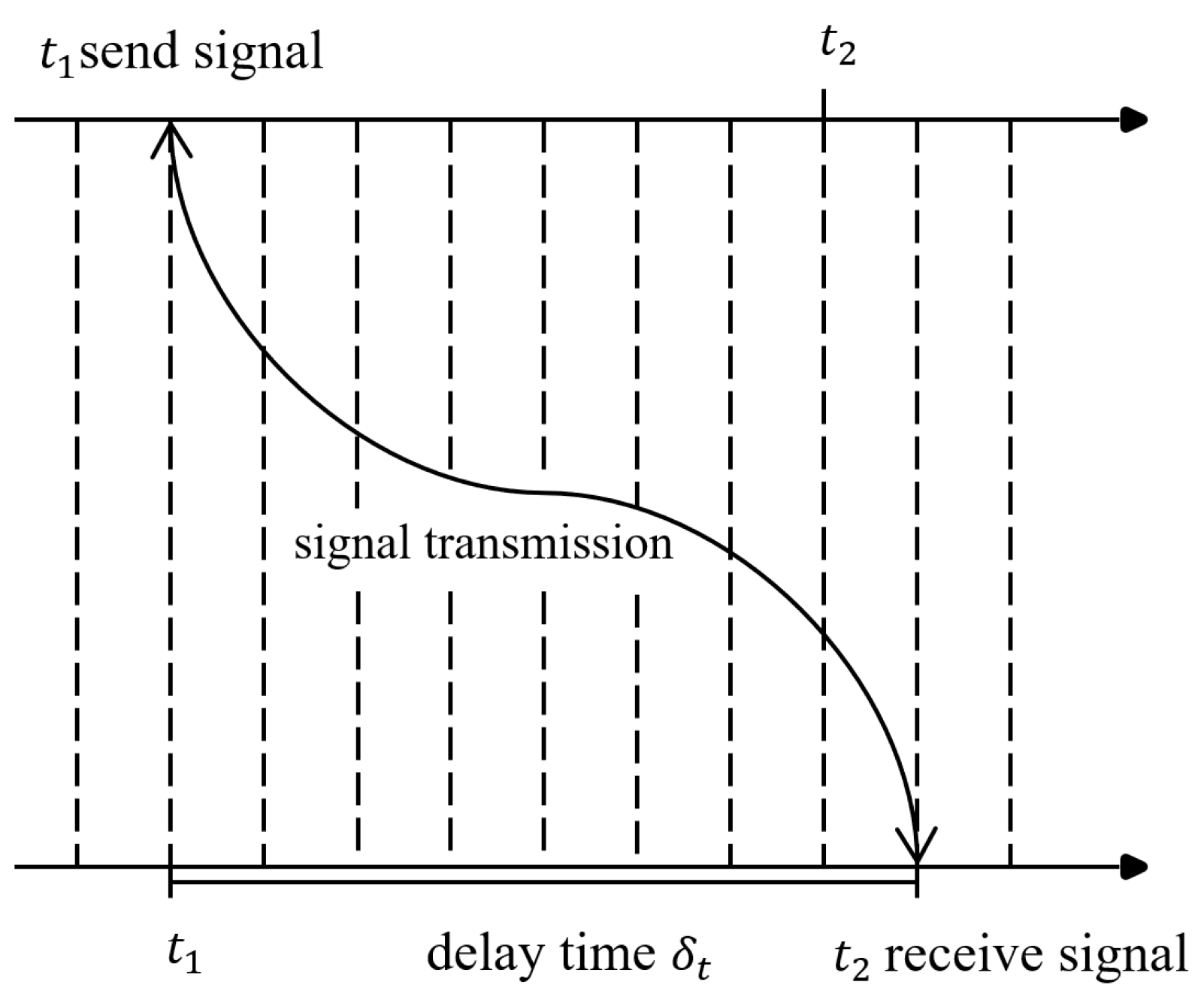
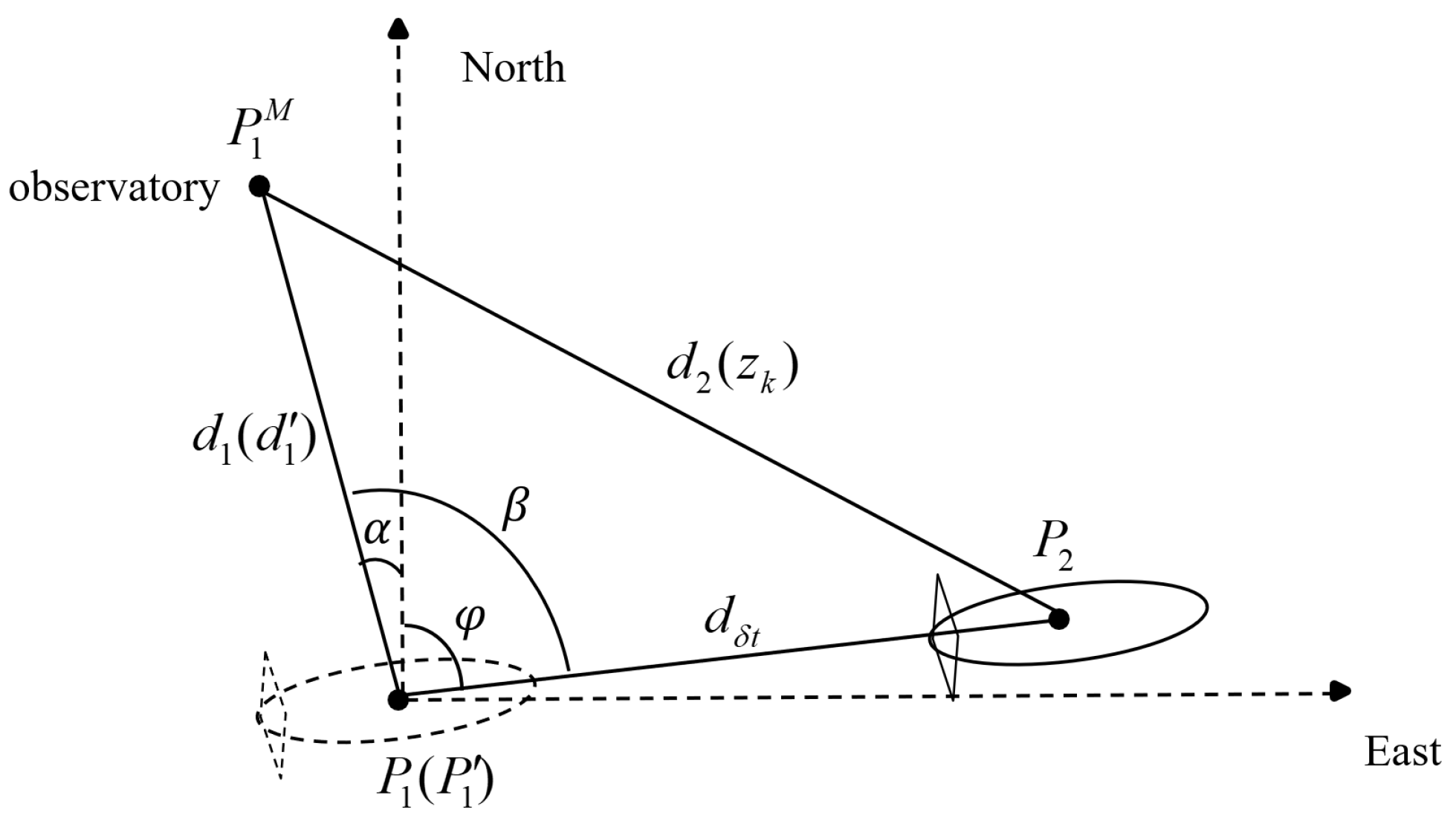
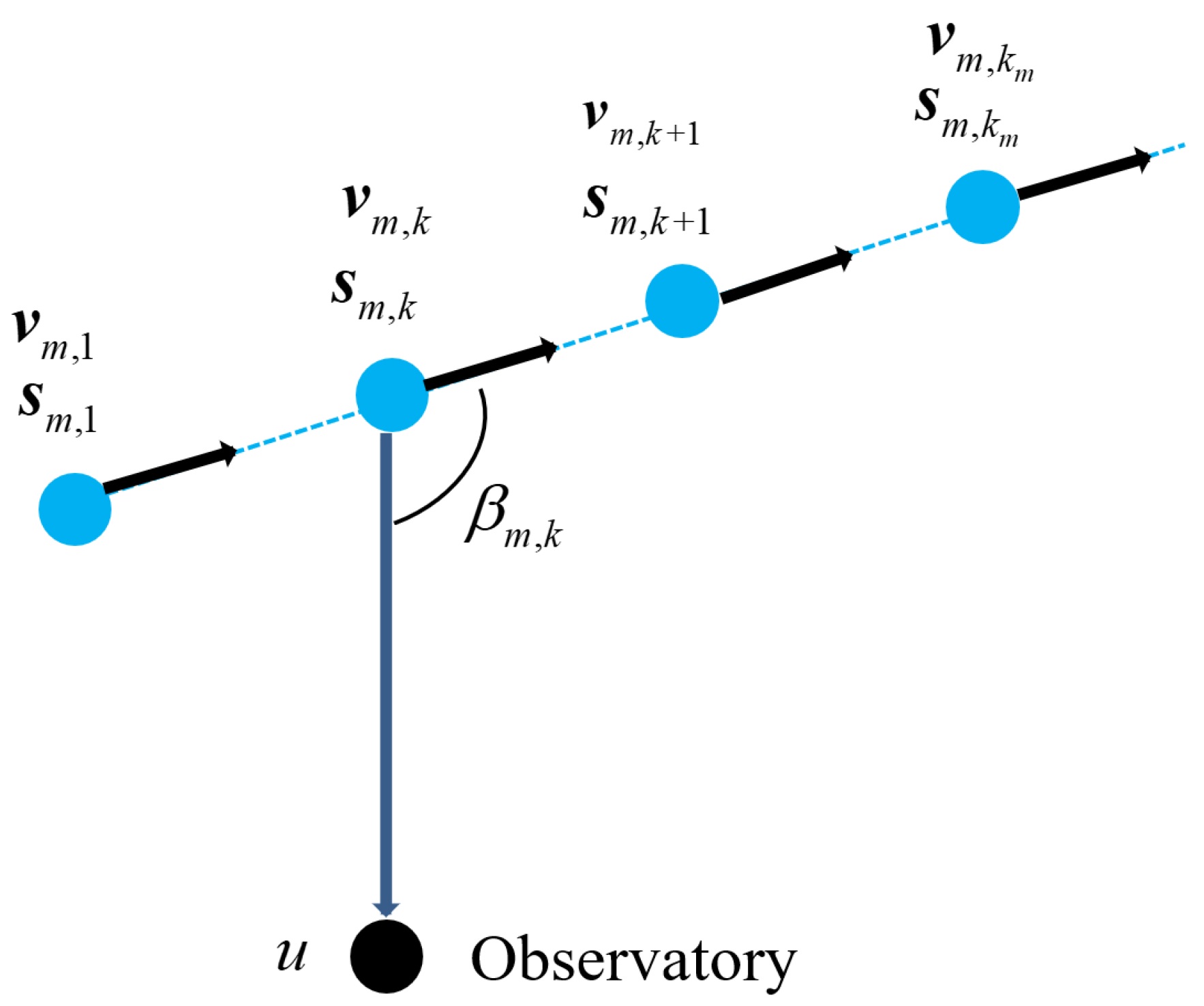
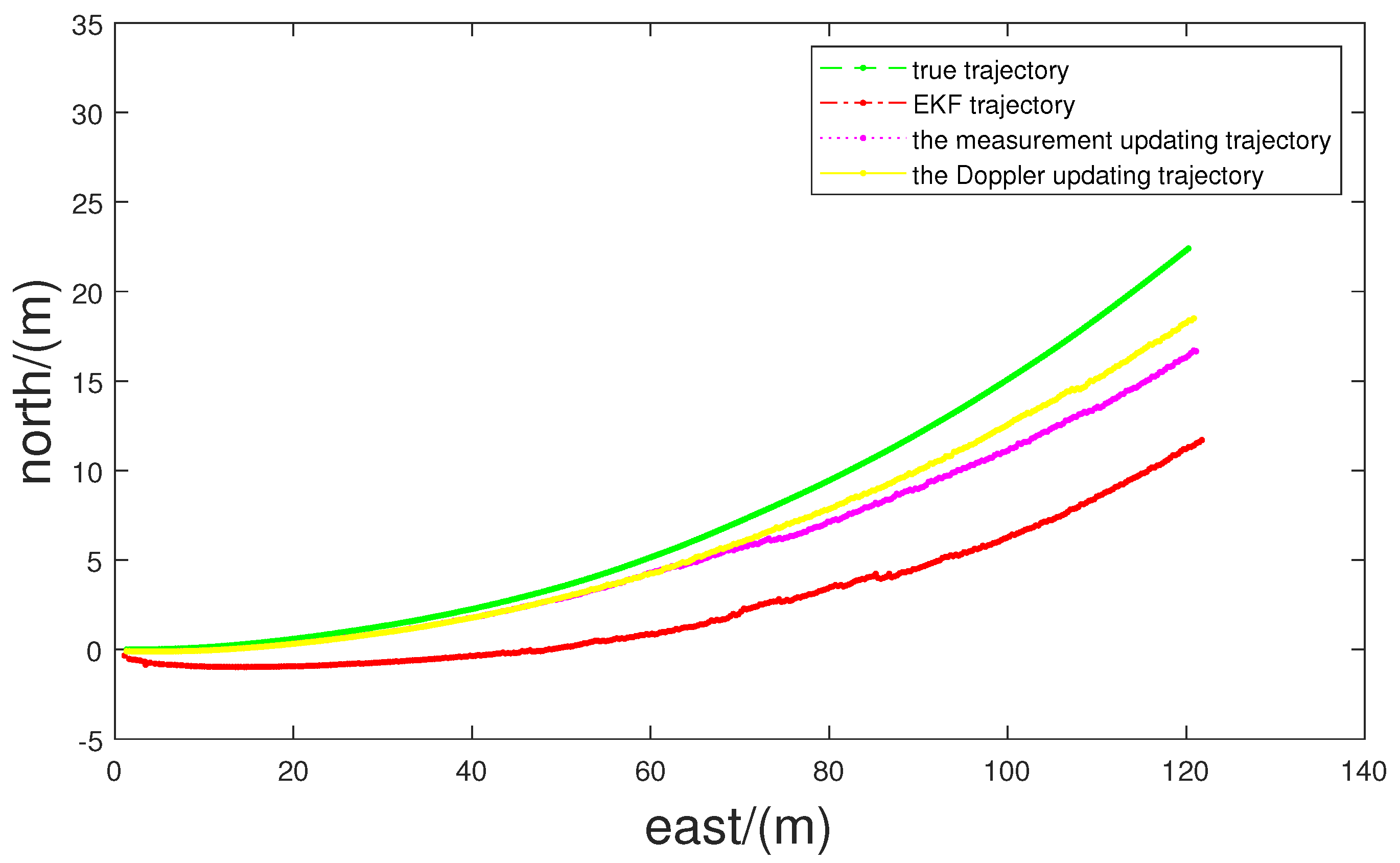



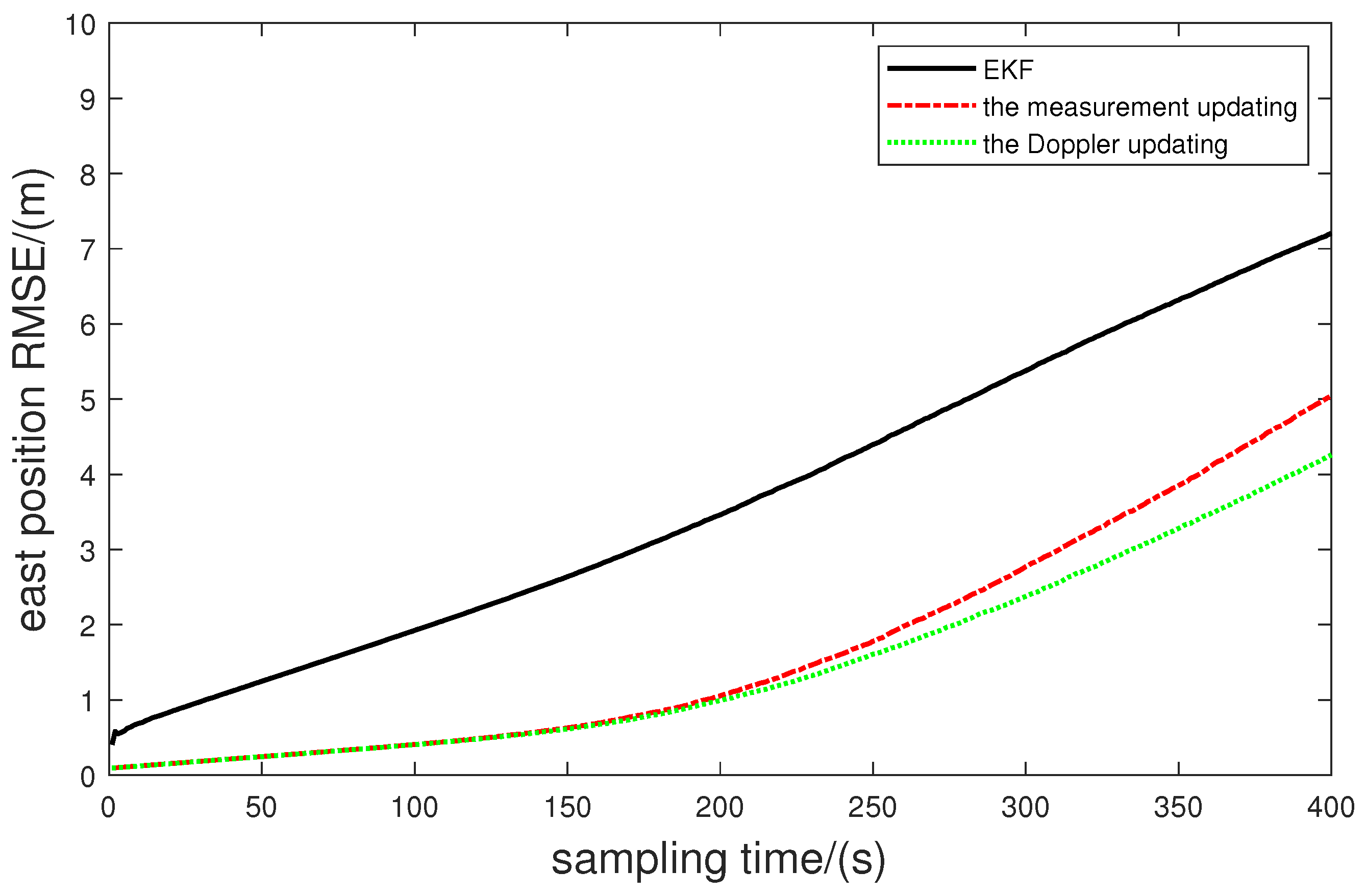
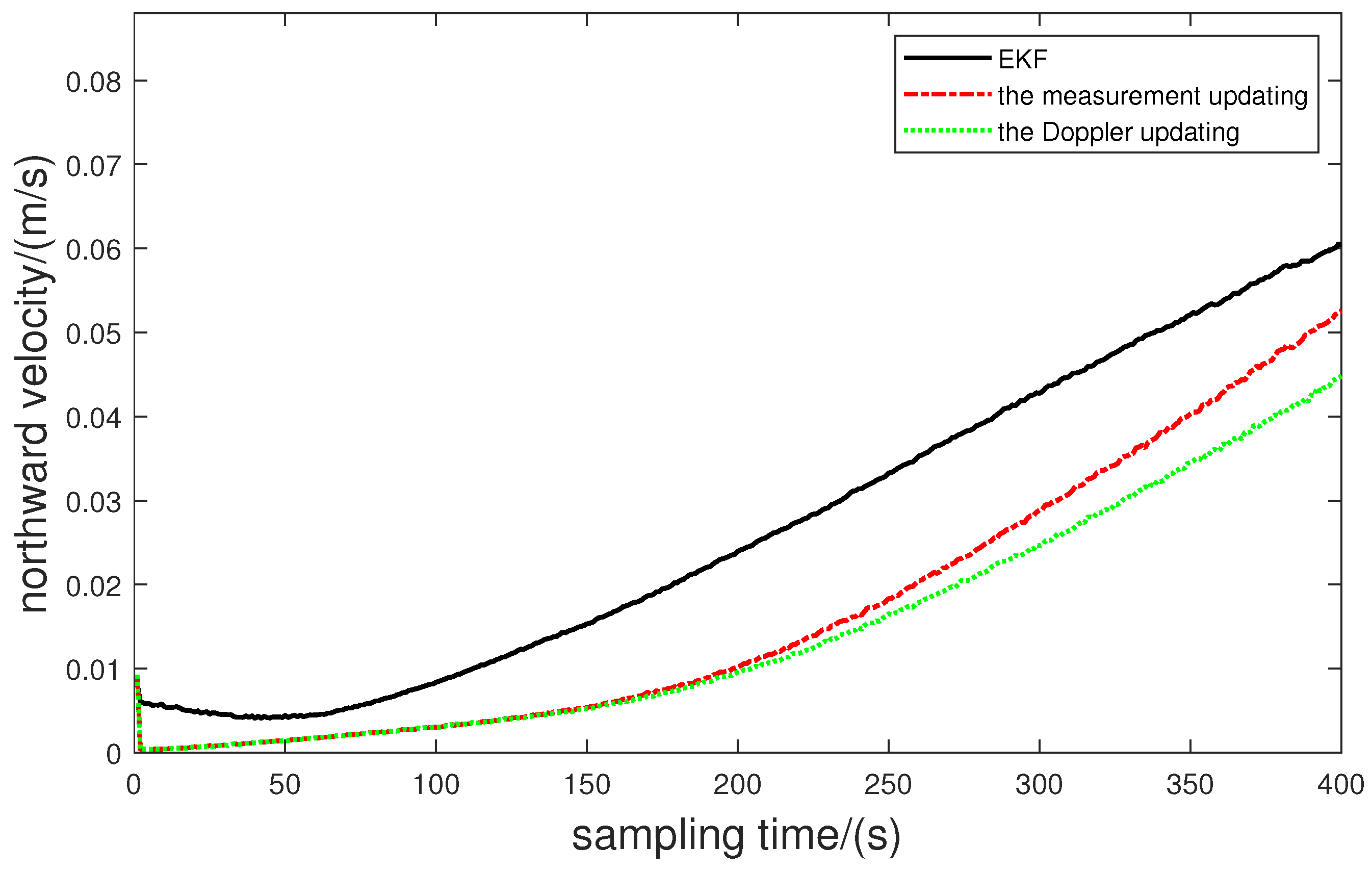
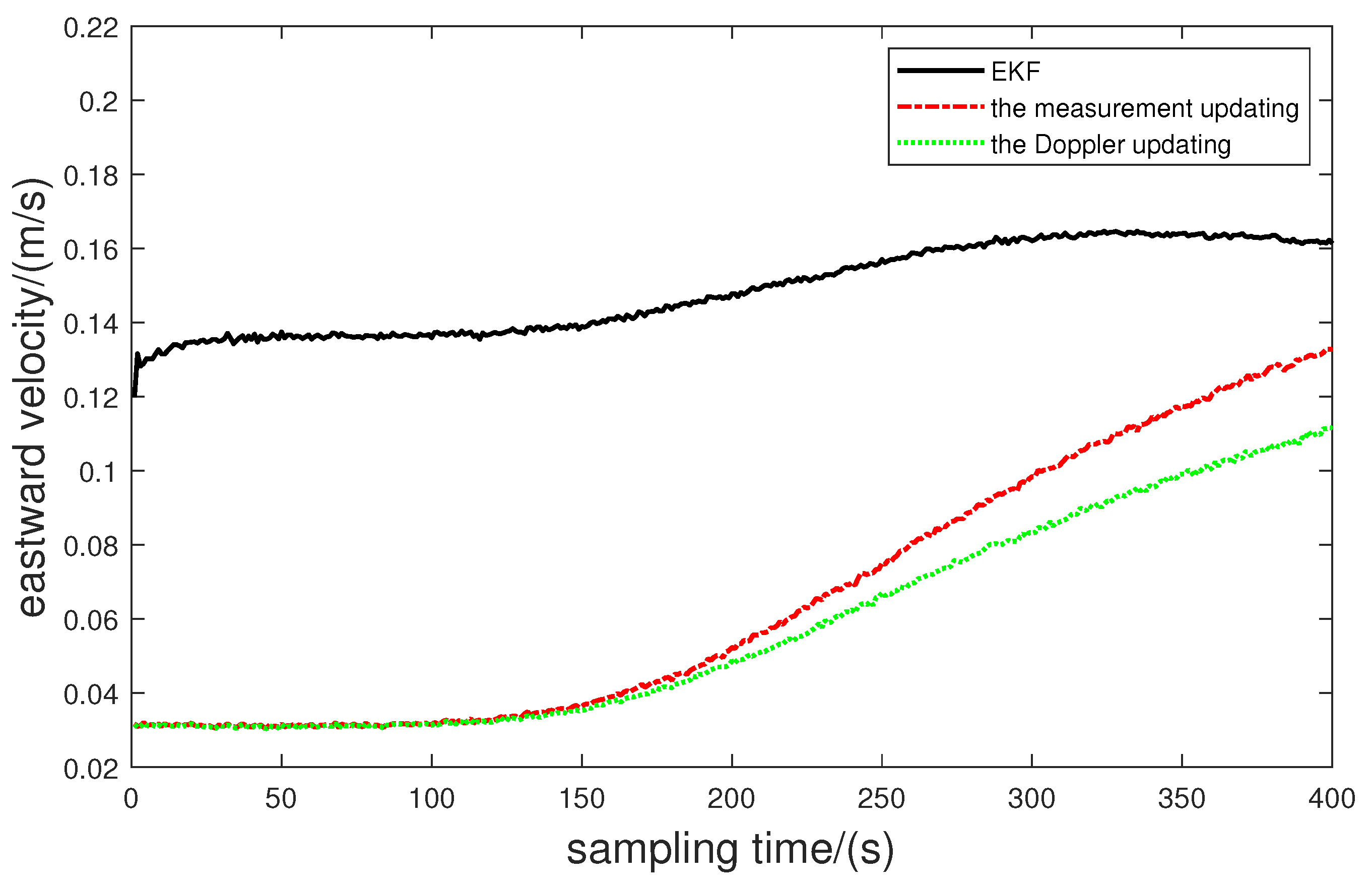
| Parameters | Value | Meaning |
|---|---|---|
| 1 s | Communication latency | |
| /s | Angular velocity | |
| v | 3 m/s | AUV travel speed |
| c | 1500 m/s | Underwater sound wave propagation speed |
| 10 kHZ | Doppler emission frequency | |
| / | System noise | |
| / | Doppler observation noise |
| Simulation | EKF | Measurement Updating | Doppler Updating | |
|---|---|---|---|---|
| 1th | Average error/(m) | 0.4768 | 2.2733 | 1.4456 |
| 2th | Average error/(m) | 1.5151 | 1.2834 | 1.5445 |
| 3th | Average error/(m) | 3.6834 | 1.6826 | 1.592 |
| 4th | Average error/(m) | 2.7569 | 2.2994 | 1.3056 |
| 5th | Average error/(m) | 1.1705 | 1.9486 | 1.4824 |
| 6th | Average error/(m) | 1.4215 | 2.2187 | 1.3861 |
| 7th | Average error/(m) | 5.4215 | 1.9356 | 1.8949 |
| 8th | Average error/(m) | 0.43878 | 2.4597 | 1.3958 |
| 9th | Average error/(m) | 3.6829 | 1.4322 | 1.634 |
| 10th | Average error/(m) | 5.1604 | 2.0432 | 1.5967 |
| … | … | … | … | … |
| 98th | Average error/(m) | 1.202 | 1.8476 | 1.4613 |
| 99th | Average error/(m) | 2.6694 | 2.0432 | 1.4002 |
| 100th | Average error/(m) | 1.2106 | 2.3533 | 1.5146 |
| EKF | Measurement Updating | Doppler Updating | |
|---|---|---|---|
| Mean of 100 experiments | 2.6167 | 2.0425 | 1.475 |
| SD | 2.0824 | 0.468 | 0.1208 |
| Comparison of errors | 100% | 78.06% | 56.37% |
Disclaimer/Publisher’s Note: The statements, opinions and data contained in all publications are solely those of the individual author(s) and contributor(s) and not of MDPI and/or the editor(s). MDPI and/or the editor(s) disclaim responsibility for any injury to people or property resulting from any ideas, methods, instructions or products referred to in the content. |
© 2024 by the authors. Licensee MDPI, Basel, Switzerland. This article is an open access article distributed under the terms and conditions of the Creative Commons Attribution (CC BY) license (https://creativecommons.org/licenses/by/4.0/).
Share and Cite
Li, P.; Li, Z.; Chen, C.; Chen, J.; Chen, Z. A High-Precision Positioning Method for Autonomous Underwater Vehicles with Communication Delays. Electronics 2024, 13, 466. https://doi.org/10.3390/electronics13030466
Li P, Li Z, Chen C, Chen J, Chen Z. A High-Precision Positioning Method for Autonomous Underwater Vehicles with Communication Delays. Electronics. 2024; 13(3):466. https://doi.org/10.3390/electronics13030466
Chicago/Turabian StyleLi, Pei, Zongyao Li, Chaoyang Chen, Juan Chen, and Zuguo Chen. 2024. "A High-Precision Positioning Method for Autonomous Underwater Vehicles with Communication Delays" Electronics 13, no. 3: 466. https://doi.org/10.3390/electronics13030466







